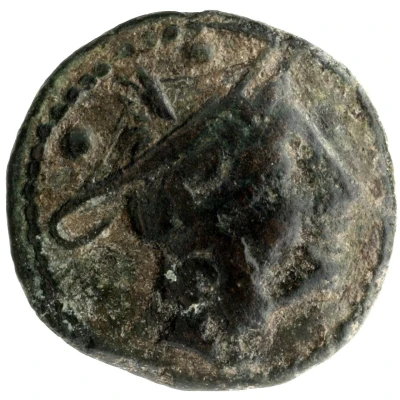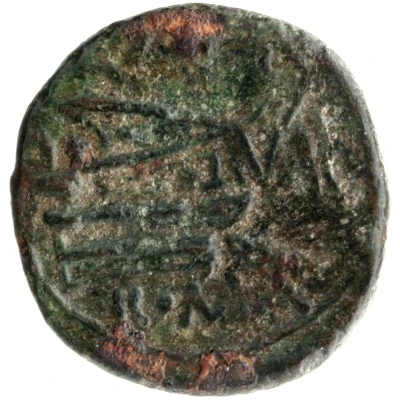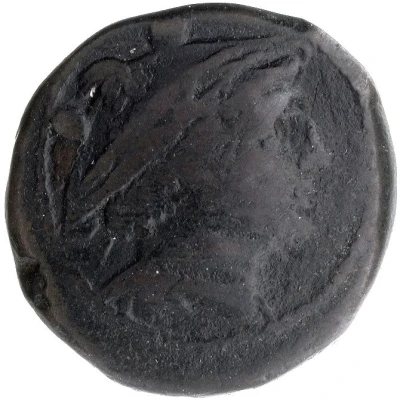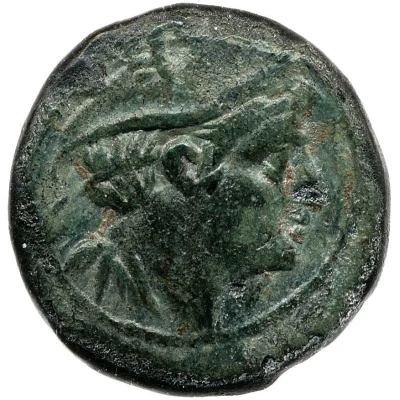
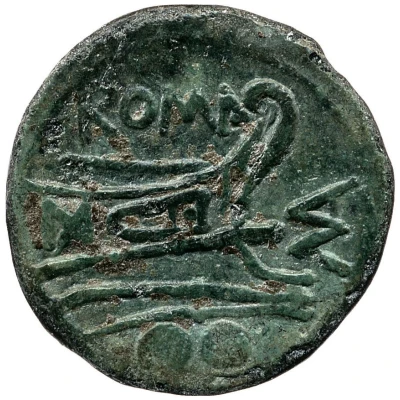

© British Museum
Sextans Publius Manlius Vulso; ROMA 210 BC
210 BC year| Bronze | 4.74 g | 19 mm |
| Issuer | Rome › Roman Republic (509 BC - 27 BC) |
|---|---|
| Issuing entity | Publius Manlius Vulso |
| Period | Republic (509 BC - 27 BC) |
| Type | Standard circulation coin |
| Year | 210 BC |
| Value | Sextans (1⁄60) |
| Currency | Denarius of 10 Asses (221 – 141 BC) |
| Composition | Bronze |
| Weight | 4.74 g |
| Diameter | 19 mm |
| Shape | Round (irregular) |
| Technique | Hammered |
| Orientation | Variable alignment ↺ |
| Demonetized | Yes |
| Updated | 2024-10-06 |
| Numista | N#385478 |
|---|---|
| Rarity index | 100% |
Reverse
Prow, right; above, inscription; before, inscription (monogram of MA); below, denominational mark.
Script: Latin
Lettering:
ROMA
MA
●●
Unabridged legend:
ROMA
Publius Manlius Vulso
Comment
Publius Manlius Vulso was a member of the Roman patrician gens Manlia. In 210 BC he was praetor of Sardinia. (Wikipedia)Sardinian mint
Weight varies from 2.64g-4.94g
RRC 64/6a
Obverse: Head of Mercury, right. Above denominational mark (●●).
Reverse: Prow, right. Below, denominational mark (●●). Before, mark (monogram of MA) - arranged vertically. Above, legend (ROMA).
@American Numismatic Society
RRC 64/6b
Obverse: Head of Mercury, right. Above, denominational mark (●●).
Reverse: Prow, right. Below, denominational mark (●●). Before, mark (M). Above, legend (ROMA).
@Bibliothèque nationale de France
RRC 64/6c
Obverse: Head of Mercury, right. Above denominational mark (●●).
Reverse: Prow, right. Below, denominational mark (●●). Before, mark (monogram of MA) - arranged horizontally. Above, legend (ROMA).
@Digitale Münzkarbinett der Universität Rostock
Interesting fact
The Sextans coin was part of a series of coins issued during the Roman Republic that featured Roman consuls and their ancestors. The coin , which features Publius Manlius Vulso, was issued in 210 BC and is an example of a "family coin" that highlighted the ancestry and achievements of a prominent Roman family. The use of ancestral imagery on coins was a common practice in ancient Rome and served as a way to reinforce social hierarchy and family lineage.
